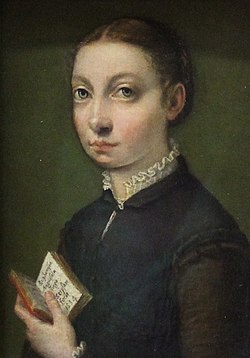| Self-Portrait | |
|---|---|
 | |
| Artist | Sofonisba Anguissola |
| Year | 1554 |
| Medium | oil on panel |
| Dimensions | 19.5 cm× 12.5 cm(7.7 in× 4.9 in) |
| Location | Kunsthistorisches Museum, Vienna |
Self-Portrait is a small oil-on-panel painting by the Italian artist Sofonisba Anguissola, signed and dated 1554 on the open book held by the artist. [1] [2] [3] The portrait is now in the Kunsthistorisches Museum, in Vienna. [4]
Contents
It was recorded as hanging in Vienna's Belvedere Gallery, already attributed to Anguissola but initially thought to be a portrait of infanta Isabella Clara Eugenia on her betrothal to her cousin Albert VII, Archduke of Austria which had therefore ended up in Vienna. [5] [6] Flavio Carioli also came to this conclusion, but in 1885 Adolfo Venturi cited a letter sent to Ercole II d'Este, Duke of Ferrara in March 1556 by Anguissola's father with two paintings by her, a self-portrait intended for the duke's daughter Lucrezia and a Cleopatra (after a drawing by Michelangelo, probably a folio now in the Casa Buonarroti). Venturi also recorded that in 1603-1604 cardinal Alessandro d'Este gave some of his paintings to Rudolf II, Holy Roman Emperor. [7] Though no inventory of the paintings given to Rudolf survives, Venturi theorises that this self-portrait was one of them and the theory is accepted by all other art historians. [8]